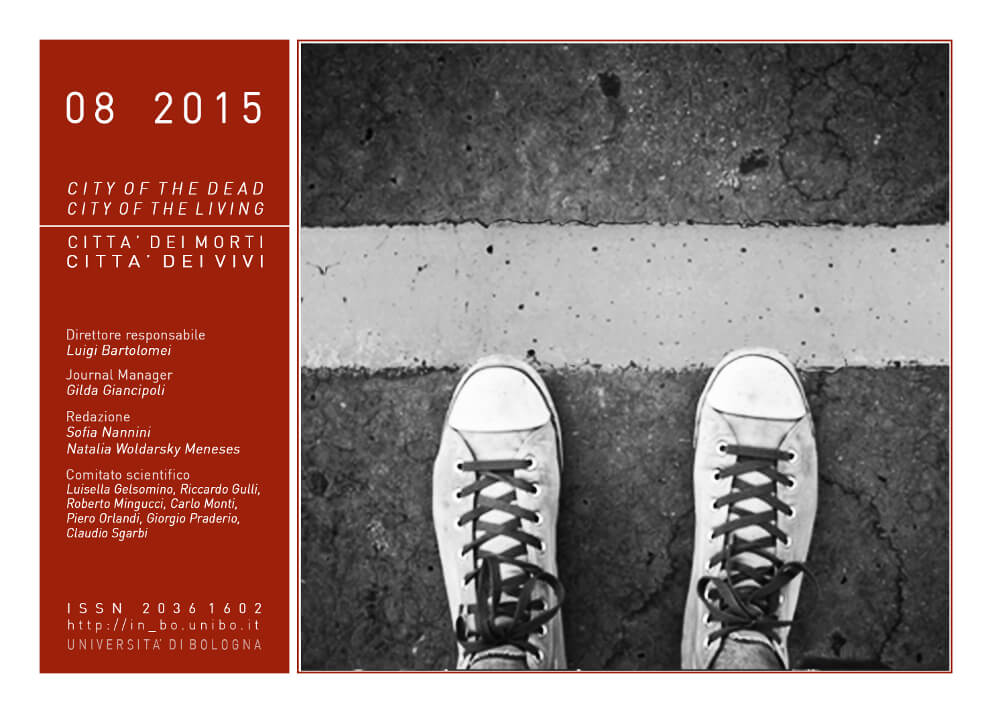Il passato è un terreno morto
DOI:
https://doi.org/10.6092/issn.2036-1602/6082Parole chiave:
Famadihana, Storiografia, Emendamento, Narrazione, MemoriaAbstract
La gran parte delle culture usa il passato per garantirsi una stabilità nel presente, rischiando tuttavia di non vedere l’altro, ma solo sé stesso. Occorre essere capaci di vedere e percepire una situazione piuttosto che esser calati entro una realtà disegnata dalla storiografia ufficiale e dalla narrativa nazionale. Partendo da acute memorie di conflitti, ingaggiati per difendere l’identità, si può sviluppare la capacità di contenere ogni eventualità e contemporaneamente procedere verso un nuovo inizio. Ambisco a interrogare i confini tracciati attraverso una lente biografica; in questo testo a questo scopo osservo sul posto/intimamente i resti del villaggio di Kufr Bir’im e del suo vicino Kibbutz Baram nel nord di Israele. L’arte di mappare i rottami può introdurre nuove strategie nell’architettura del conflitto.Riferimenti bibliografici
Meron Benvenisti, [trans. Maxine Kaufman-Lacusta] Sacred Landscape – The Buried History of the Holy Land since 1948, University of California Press, Berkeley/Los Angeles/London 2000
Mahmoud Darwish, [trans. Ibrahim Nuhawi] Memory for Forgetfulness, University of California Press, Berkeley/Los Angeles/London 1982
Peter Eisenman, “En Terror Firma–In trails of Grotexts”, in Kate Nesbitt, Theorizing a New Agenda for Architecture. An Anthology of Architectural Theory 1965-1995, Princeton Architectural Press, New York 1996
Giuliana Bruno, Atlas of Emotion. Journeys in Art, Architecture and Film. Verso, New York 2002
Maurice Halbwachs, On Collective Memory, University of Chicago Press, Chicago/London 1992
Noga Kadman,Erased from Space and Consciousness: Depopulated Palestinian Villages in the Israeli Zionist Discourse, November Books, Tel Aviv 2008
David Lowenthal, The Past is a Foreign Country, Cambridge University Press, Cambridge 1985
Haviva Pedaya, “Spaces: Real, Symbolic, Imaginary and Reality”, in Haviva Pedaya, Expanses: An Essay on the Theological and Political Unconscious, Hakibbutz Hameuchad, Tel Aviv 2011, pp. 21-28
Irit Rogoff,Tera Infirma. Geography of Visual Culture, Routledge, Abingdon/New York 2005
Antony Vidler, The Architectural Uncanny. Essays in the Modern Unhomely, MIT Press, Cambridge/London 1992
Yona Weitz, “Memory in the Shadow of Genocide: The Memory of the Armenian Genocide in the Armenian Community of Jerusalem”, Ph.D. Thesis; The Hebrew University of Jerusalem 2010
W.J.T. Mitchell, “Holy Landscape: Israel, Palestine and the American Wilderness”, in W.J.T. Mitchell (ed.) Landscape and Power. “Cristo’s Gates and Gilo’s Wall” in W.J.T. Mitchell, Critical Inquiry, n. 32 (June 1, 2006). University of Chicago Press, pp. 261-290
Downloads
Pubblicato
Come citare
Fascicolo
Sezione
Licenza
Copyright (c) 2015 Nilly R. Harag
I diritti d'autore e di pubblicazione di tutti i testi pubblicati dalla rivista appartengono ai rispettivi autori senza alcuna restrizione.
Questa rivista è distribuita con licenza Creative Commons Attribuzione - Non commerciale 4.0 Internazionale (licenza completa).
Vedere anche la nostra Open Access Policy.
Metadati
Tutti i metadati dei materiali pubblicati sono rilasciati in pubblico dominio e possono essere utilizzati da ognuno per qualsiasi scopo. Questi includono i riferimenti bibliografici.
I metadati – riferimenti bibliografici inclusi – possono essere riutilizzati in qualsiasi formato senza ulteriori autorizzazioni, incluso per scopo di lucro. Chiediamo cortesemente agli utenti di includere un collegamento ai metadati originali.






